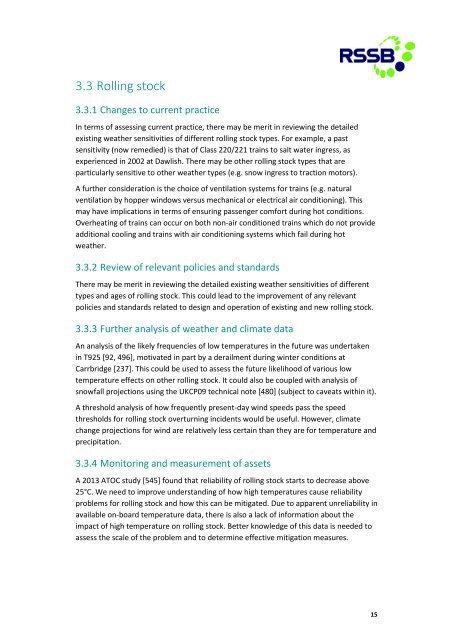Tomorrow's Railway and Climate Change Adaptation Final Report
2016-05-T1009-final-report
2016-05-T1009-final-report
Create successful ePaper yourself
Turn your PDF publications into a flip-book with our unique Google optimized e-Paper software.
3.3 Rolling stock<br />
3.3.1 <strong>Change</strong>s to current practice<br />
In terms of assessing current practice, there may be merit in reviewing the detailed<br />
existing weather sensitivities of different rolling stock types. For example, a past<br />
sensitivity (now remedied) is that of Class 220/221 trains to salt water ingress, as<br />
experienced in 2002 at Dawlish. There may be other rolling stock types that are<br />
particularly sensitive to other weather types (e.g. snow ingress to traction motors).<br />
A further consideration is the choice of ventilation systems for trains (e.g. natural<br />
ventilation by hopper windows versus mechanical or electrical air conditioning). This<br />
may have implications in terms of ensuring passenger comfort during hot conditions.<br />
Overheating of trains can occur on both non-air conditioned trains which do not provide<br />
additional cooling <strong>and</strong> trains with air conditioning systems which fail during hot<br />
weather.<br />
3.3.2 Review of relevant policies <strong>and</strong> st<strong>and</strong>ards<br />
There may be merit in reviewing the detailed existing weather sensitivities of different<br />
types <strong>and</strong> ages of rolling stock. This could lead to the improvement of any relevant<br />
policies <strong>and</strong> st<strong>and</strong>ards related to design <strong>and</strong> operation of existing <strong>and</strong> new rolling stock.<br />
3.3.3 Further analysis of weather <strong>and</strong> climate data<br />
An analysis of the likely frequencies of low temperatures in the future was undertaken<br />
in T925 [92, 496], motivated in part by a derailment during winter conditions at<br />
Carrbridge [237]. This could be used to assess the future likelihood of various low<br />
temperature effects on other rolling stock. It could also be coupled with analysis of<br />
snowfall projections using the UKCP09 technical note [480] (subject to caveats within it).<br />
A threshold analysis of how frequently present-day wind speeds pass the speed<br />
thresholds for rolling stock overturning incidents would be useful. However, climate<br />
change projections for wind are relatively less certain than they are for temperature <strong>and</strong><br />
precipitation.<br />
3.3.4 Monitoring <strong>and</strong> measurement of assets<br />
A 2013 ATOC study [545] found that reliability of rolling stock starts to decrease above<br />
25°C. We need to improve underst<strong>and</strong>ing of how high temperatures cause reliability<br />
problems for rolling stock <strong>and</strong> how this can be mitigated. Due to apparent unreliability in<br />
available on-board temperature data, there is also a lack of information about the<br />
impact of high temperature on rolling stock. Better knowledge of this data is needed to<br />
assess the scale of the problem <strong>and</strong> to determine effective mitigation measures.<br />
15


